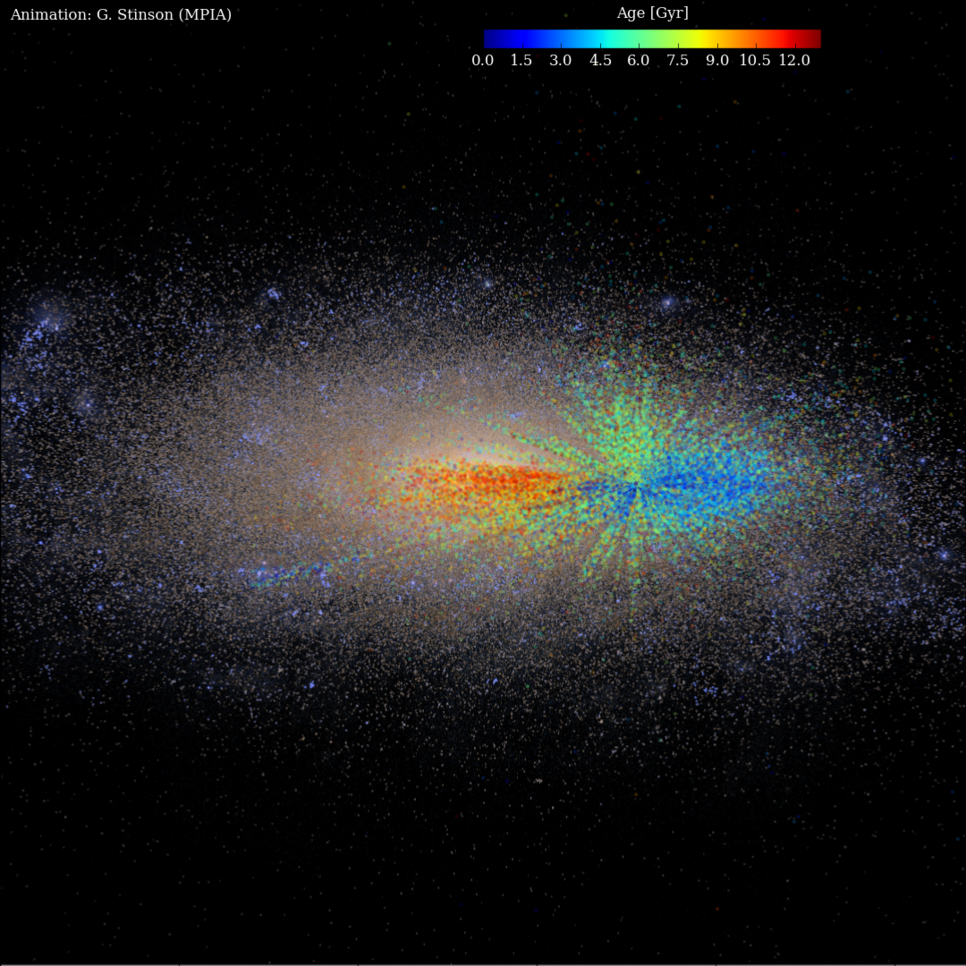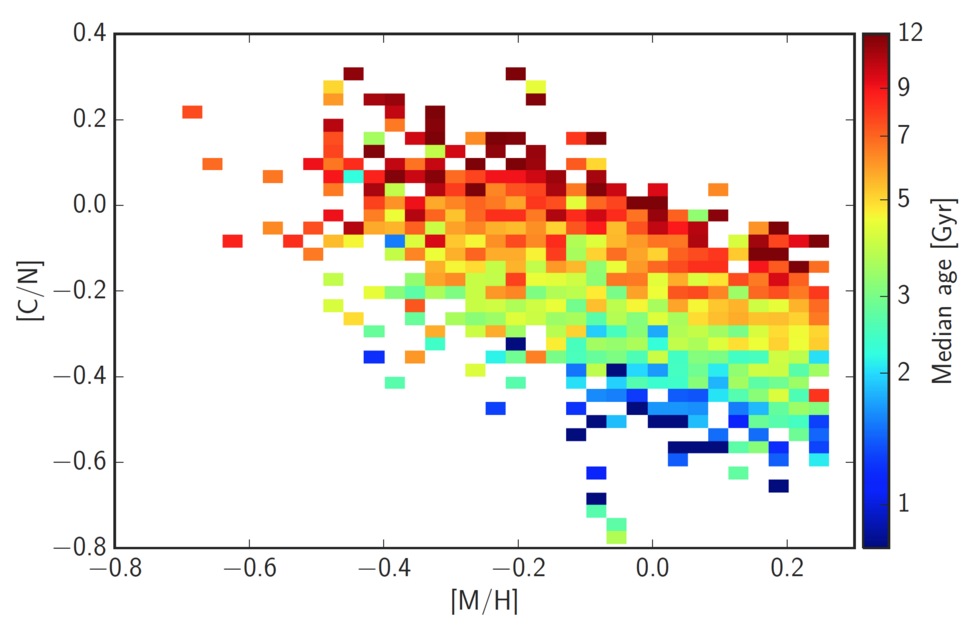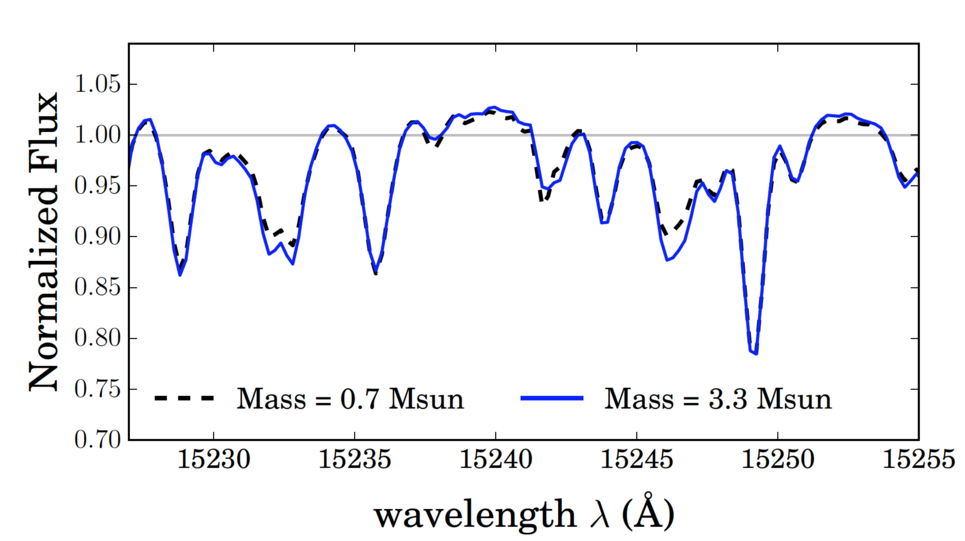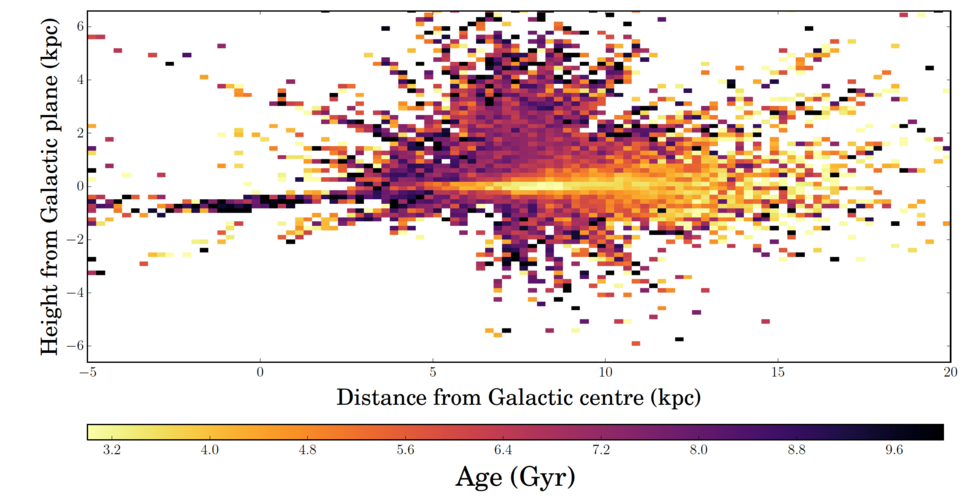Making (galactic) history with big data: First global age map of the Milky Way
Using completely new ways of deducing the ages of so-called red giant stars from observational data, astronomers have created the first large-scale map that shows stellar ages in the Milky Way. Determining the ages of nearly 100 000 red giant stars, at distances of up to 50 000 light-years from the galactic center, the astronomers, led by Melissa Ness and Marie Martig of the Max Planck Institute for Astronomy, were able to test key ideas about the growth of the Milky Way. Notably, the map confirms that our home galaxy has grown inside out: in the present epoch, most old stars can be found in the middle, more recently formed ones in the outskirts.
| Background information | Additional images and downloads | In-depth description of the results |

In the past decades, powerful astronomical surveys have provided astronomers with data about millions of astronomical objects, allowing for large-scale statistical analysis. But big data of this kind is only as good as the tools available for analysis. Now, Melissa Ness and Marie Martig of the Max Planck Institute for Astronomy have added two powerful new tools to astronomy's arsenal: Using sample data from the APOGEE survey (part of the Sloan Digital Sky Survey) and NASA's Kepler Space Telescope, Ness and Martig devised two independent methods for determing the age of a red giant star from its spectrum (that is, from the properties of its light).
Using these methods, the astronomers were able to estimate the ages of nearly 100 000 stars that had been observed with the APOGEE survey. The result is an age map of the Milky Way, showing exactly which regions of our galaxy harbour young, old or middle-age stars (cf. figure 1). The map provides a representative cross section from the center of the Milky Way to the outskirts at a distance of 65 000 light-years from the galactic center.
With an age map of this kind, current models of how our home galaxy came into being and evolved can be put to the test. For instance, such models predict that stellar disks, the dominant stellar component of galaxies like the Milky Way, should have formed from the inside out: so, one would expect to find the older stars closer to the galactic center, and the younger stars at the outside. The map confirms this distribution.
Also, at any given radius, the younger stars are typically found closer to the galactic plane than their older cousins. This is also confirmed by the age map of Ness and colleagues.
Techniques such as these promise much greater advantages once the data from future surveys such as APOGEE-2 or ESA's Gaia mission are in. Eventually, it could help astronomers to reconstruct the entire star formation history of our galaxy: how many stars within our galaxy were formed at different times of galactic history, and in which regions, and how these stars have enriched our galaxy's raw material with the various elements they produce via nuclear fusion (thus enabling the production of heavier elements, of planets and, eventually, of living beings).
Background information
The results described here are published in Ness et al. The Cannon: A Data-driven Approach to Stellar Label Determination (published, Astrophysical Journal), Spectroscopic determination of masses (and implied ages) for red giants (Preprint, submitted to Astrophysical Journa), and Martig et al. Red giant masses and ages derived from carbon and nitrogen abundances (accepted for publication in MNRAS).
Melissa Ness will present these results at a press conference at the annual meeting of the American Astronomical Society on Friday, January 8, after 10:15 am local time (16:15 CET). The press conference can be seen live as webcast. Please contact AAS Press Officer Rick Fienberg for access to the webcast.
An in-depth description of the research and scientific background is available here.
The SDSS press release describing these results can be found here.
The researchers from the Max Planck Institute for Astronomy involved in the research were
Melissa Ness, Marie Martig, Hans-Walter Rix, David Hogg (also New York University), Morgan Fouesneau and Anna Y.Q. Ho (also Caltech)
in collaboration with
Marc H. Pinsonneault (Ohio State University), Szabolcs Mészáros (ELTE Gothard Astrophysical Observatory, Hungary), D. A. García-Hernández and Olga Zamora (both Instituto de Astrofísica de Canarias and Departamento de Astrofísica, Universidad de La Laguna), Aldo Serenelli (Instituto de Ciencias del Espacio (ICE/CSIC-IEEC) Campus UAB), and Victor Silva Aguirre (Aarhus University)
Additional images and download area


Abbildung 3: Beispiele für die Unterschiede in den Spektren Roter Riesensterne in Abhängigkeit von der Sternmasse. Die hier eingezeichneten Unterschiede ergeben sich aus dem flexiblen statistischen Modell, das Ness et al. mit The Cannon erstellten. Zu sehen ist der Unterschied zwischen einem Roten Riesen mit 0.7 Sonnenmassen und einem mit 3.3 Sonnenmassen. Aus Unterschieden dieser Art schließen Ness et al. auf die Massen der beobachteten Roten Riesen.

Abbildung 4: Altersverteilung für eine Stichprobe von Roten Riesensternen in unterschiedlichen Abständen vom galaktischen Zentrum bis hin zu den Randgebieten unserer Milchstraße. Die waagerechte Achse zeigt die Abstände vom galaktischen Zentrum, die senkrechte Achse die Entfernung des Sterns von der galaktischen Scheibenebene (nicht maßstabsgetreu). Die Farbgebung der Pixel zeigt das durchschnittliche Alter der Roten Riesen an, die Ness et al. in der betreffenden Region im Diagramm beobachtet haben. Deutlich sichtbar ist, dass junge Sterne insbesondere nahe der Scheibenebene vorkommen. Auch die Altersverteilung, die anzeigt, dass die Scheibe unserer Milchstraße von innen nach außen gewachsen ist und das mit der Zeit immer mehr Sterne in immer weiter außen liegenden Regionen hinzugekommen sind ist gut zu sehen.
Downloads:



